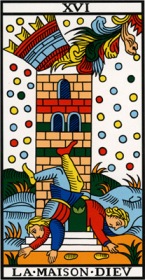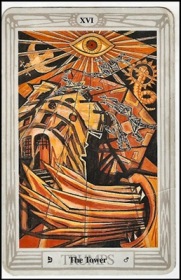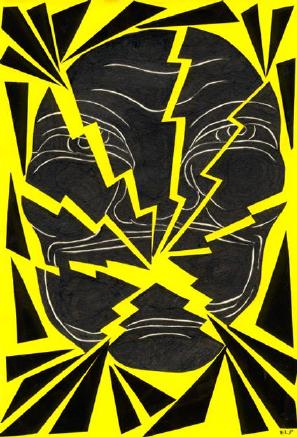The other day, I was playing with the wonderful Tarot of the Crone, by the great Ellen Lorenzi-Prince , when I realized something quite interesting. It was one of those findings that are so evident, you’re really surprised you never noticed it before. In this case, it was how common it is to picture the Tower card with a tower tumbling down.
Of course that image, as related to the “Tower of Babel” story, one of the fundamental meanings of the card, is appropriate. However, some artists do tend to choose other ways to depict all the violence and mayhem and disorientation that the card is supposed to convey. Case in point, Ellen’s choice for the Tower card:
Here we have an old woman (a crone) shouting so hard, the entire image shatters. There’s a profound sense of pain and revolt, like there’s so much bad things in her life, she just can’t handle them anymore and simply has to scream. A scream so strong and painful it ends up shattering the very idea we have from her. We can see the violence, the pain and the frustration this woman feels. But, at the same time, we also get a sense of release, of liberation. Like she’s finally releasing herself from all that excess baggage and can move forth.
As Ellen puts it in her description of the card,
I am the Mother of MadnessWhen I speak
I screamWhen I scream
things shatterI scream
Because these things are wrongAnd I cannot have it so
Now this set my mind racing and the first stop was at greek-descendent american singer, Diamanda Galás. Diamanda’s work has focused on such issues as AIDS, the armenian massacre, injustice, mental illness and, more recently, love songs. Armed with a three-and-a-half octave voice (which, for those of you who doesn’t know means she can reproduce more or less 50% of all the sounds you can get from a piano), she was known by saying,
“My voice was given to me as an instrument of inspiration for my friends, and a tool of torture and destruction to my enemies. An instrument of truth.”
Now compare this with the description Ellen gave. Diamanda is known to have a voice that can shatter the usual conventions of musicality. And with albums such as “Wild Women With Stake Knives”, or “Schrei X” she does exactly that.
But there was a particular song of her that I wanted to address: the Cri d’Aveugle, based on the poem by Tristan Corbière, which was released in the Saint of the Pit album (as part of the Masque of Red Death Trilogy). The music, speaks about a blind man and his desperation about being blind. His eyes were just poked with a spike, by someone like an inquisitor. There’s pain and hurt and he feels there’s no reason left to live, as everything he believed is now gone, along with his eyes. Diamanda even goes as far as incorporating the classical phrase Jesus Christ said on the cross “Eli, Eli, Lamma lamma sabacthani” (My God, My God, why hast Thou forsaken me?). It’s a very powerful text and one that fits like a glove on the ambience of the Tower card:
L’oeil tué n’est pas mort
Un coin le fend encor
Encloué je suis sans cercueil
On m’a planté le clou dans l’oeil
L’oeil cloué n’est pas mort
Et le coin entre encorDeus misericors
Deus misericors
Le marteau bat ma tête en bois
Le marteau qui ferra la croix
Deus misericors
Deus misericorsLes oiseaux croque-morts
Ont donc peur à mon corps
Mon Golgotha n’est pas fini
Lamma lamma sabacthani
Colombes de la Mort
Soiffez après mon corpsRouge comme un sabord
La plaie est sur le bord
Comme la gencive bavant
D’une vieille qui rit sans dent
La plaie est sur le bord
Rouge comme un sabordJe vois des cercles d’or
Le soleil blanc me mord
J’ai deux trous percés par un fer
Rougi dans la forge d’enfer
Je vois un cercle d’or
Le feu d’en haut me mordDans la moelle se tord
Une larme qui sort
Je vois dedans le paradis
Miserere, De profundis
Dans mon crâne se tord
Du soufre en pleur qui sortBienheureux le bon mort
Le mort sauvé qui dort
Heureux les martyrs, les élus
Avec la Vierge et son Jésus
O bienheureux le mort
Le mort jugé qui dortUn Chevalier dehors
Repose sans remords
Dans le cimetière bénit
Dans sa sieste de granit
L’homme en pierre dehors
A deux yeux sans remordsHo je vous sens encor
Landes jaunes d’Armor
Je sens mon rosaire à mes doigts
Et le Christ en os sur le bois
A toi je baye encor
O ciel défunt d’ArmorPardon de prier fort
Seigneur si c’est le sort
Mes yeux, deux bénitiers ardents
Le diable a mis ses doigts dedans
Pardon de crier fort
Seigneur contre le sortJ’entends le vent du nord
Qui bugle comme un cor
C’est l’hallali des trépassés
J’aboie après mon tour assez
J’entends le vent du nord
J’entends le glas du cor
———–
Dios, porque me has condendado?
mavpes apakvuthes!
lamma sabacthani!
Esta es mi sangre
Este es mi cuerpo
Estas son mis venas
Estoy siego
Dios, no puedo ver!
mavpes apakvuthes!
lamma sabacthani!
Aves de la muerte
Quiten me la vida!
lamma lamma
sabacthani!
Hopelessness. Darkness. Fear. Pain. Anguish. Punishment. Concepts that keep coming to mind when confronted by the XVIth Major Arcana. However, there’s another part of the story. Something that’s subtly represented by the common image of the falling tower, which tells us of the possibility of release. If everything we’ve built tumbles down, we’re free to start over. We’re free from previous obligations and baggage. Free to come along.
In the Tarot of the Crone image, we see this as the shattering of the Crone image. A light so strong that actually pierces through all the dark things in her life. A scream just like you hear in any of Diamanda’s songs, that seems like it’s gutting our entrails with a stake knife, but can also be cathartic. There’s darkness in the Tower card, but in some way or another, there’s also light. Or the prospect of light. In two of the three Tower cards from “Holy Trinity” of tarot decks (Marseille, Rider-Waite Smith and Toth deck), you get to feel this darkness that’s imbedded on the card. Even though the actual towers are colored Grey (RWS) and orange (Toth), there’s no escaping all that blackness that permeates the whole card. The absence of light, with the exception of the light brought forth by the Divine Punishment.
We know that when the Tower card appears we can expect the destruction of everything that’s unbalanced or unstable or just simply has to go. We are expected to break free from everything the Tower represents. This Dark Prison. And go forth into the pathway of the light, as symbolized by the triad Star-Moon-Sun, the dark night of the soul almost over.
Philip K. Dick (PKD) was an american writer who, in the midst of a breakdown due to depression, drugs, a paranoid mind and whatever else was going on, had a revelation. In March 1974, a pink ray descended from the sky, more specifically, from God. Or aliens. Or a Vast Active Living Organism (also known as V.A.L.I.S.) and rewired his entire brain. This experience is described at length in his Valis novel and in his Exegesis writings. There’s also plenty of papers discussing his experience, including an academic thesis. Of interest here is a term he coined, The Black Iron Prison, which was meant to signify every government, every school, every institution, every political force that enforced an oppressive control on people and society. This would be symbolized by the Roman Empire, that paragon of everything that went wrong with the use of power. According to him, “The Empire Never Ended” (people who think the Matrix movies, or even the Star Wars trilogies or its simulacra brought forth in terms of original ideas and concepts should really pay more attention to what was being put forth by people like PKD and Jack Kirby and others from the 50s onwards…).
This notion was put forth in his Tractates Crytptica Scriptura, a part of his Exegesis that he worked into the VALIS novel. According to him, liberation was only possible by Divine Intervention. By a “ray of information” that would come forth from the Divinity itself (or aliens; or VALIS) and would allow us to break free from this Iron Prison. Also according to him, this bringing forth of information occurred in August 1974 (paragraph #17 of the Tractates Cryptica Scriptura), when we entered the Age of Gold, symbolized by a Palm Tree garden (hopefully, the same Palm Tree garden we find on the RWS’s High Priestess card…).
A ray of information such as the one seen on the Tower cards of the RWS, the Toth deck, the Marseille or even, the inner light that comes forth from the depths of the Crone woman. Divine intervention designed not really to punish ourselves, but to give us the necessary tools to effectively break out from the Iron Prison and escape the oppression of the Empire. Whether it exists outside of us in every social construct that employs what Foucault calls the “technology of power” or, perhaps, inside of us, in the very mechanisms we’ve built to sustain ourselves and cope what life brings forth.




